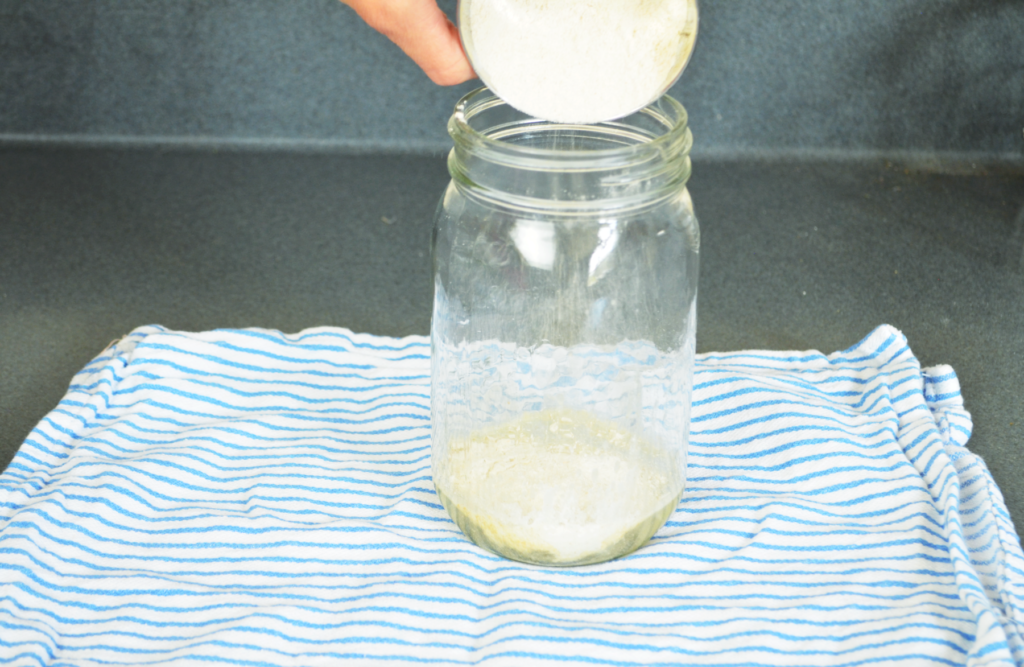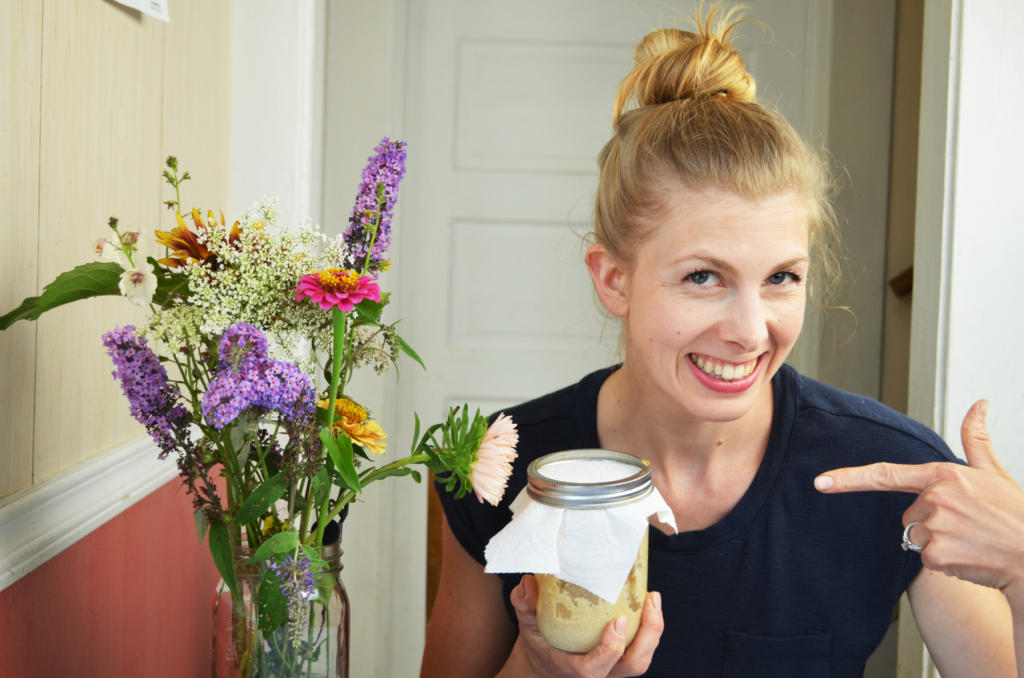Simple Recipe for Einkorn in Sourdough Starter
The popularity and usage of sourdough starter has gone up tremendously since 2020. It was affordable, easy to use, and only took two ingredients. For awhile, I used a sourdough starter given from a friend. “Why would I start my own? That sounds intimidating to say the least!” Then when we switched off all modern wheat, I transitioned my sourdough starter to an einkorn sourdough starter and it was easy. If you haven’t learned of the amazing benefits of einkorn wheat, check out THIS POST. I began to wonder about making my own starter. “Could einkorn in sourdough starter be simple or difficult?” I’d made so many sourdough recipes I should know this! The answer is it’s not difficult. The high quality einkorn gives quick results and makes it easy. This recipe for einkorn in sourdough starter is not hard at all. I’ll show you haw it works.

Time: When Sourdough Starter is Ready
Getting your einkorn sourdough starter to a point where you can use it will take a couple weeks to a month BUT the process of making it only takes about FIVE DAYS.
The first THREE days are the most important.
You’ll start by feeding the sourdough starter morning and evening for about three-five days. Then you will maintain it once a day after that. I’ll explain the maintenance below.
You’ll know when sourdough starter is ready and mature because it can go for several days without food. I wouldn’t test it though! Just take it from me that the time frame to mature your sourdough starter will be close to a month. Be patient. You’ll get to make that einkorn starter recipe you’ve been waiting for!

What Einkorn Flour To Use
When making this recipe for einkorn in sourdough starter, you’ll want to use Whole Grain Einkorn Flour. Germ on your wheat carries much of the good organisms that make your sourdough starter. If you use a refined flour (all-purpose einkorn flour) you’ll make it much harder to start the yeast activity. After your starter is mature, you may use all-purpose einkorn if you wish to maintain it, but I’ll always recommend whole grain einkorn flour due to the higher amount of those organisms.
I’m partial to freshly ground einkorn that I mill on my Mockmill. I’ve been so happy with the grain from our neighbor state Idaho! Yup! Grand Tetons Ancient Grains has Northwest grown einkorn grain. Not only do I know it will be fresh, encouraging more live organisms, but it also comes out warm: perfect for feeding sourdough starters. They love it.
How Sourdough Works
Let’s go over a quick recap of what sourdough starter is. There are organisms throughout nature that ferment yogurt, pickles, wine, cheese and more. What looks like a “reaction” is actually organisms being fed and giving off alcohol that we see as bubbles. The more bubbles, the more they are enjoying their food.
What exactly is their food? When water and flour are mixed, the enzymes of the flour break down long starch molecules into simple sugars that yeast loves. This produces the fuel for your starter. Don’t stop mixing that water and flour. You need more sugars and more yeast to eat it. This keeps your sourdough starter active and happy. For more on the science of how sourdough works, check out the book “Sourdough by Science” where Karyn Lynn Newman explains the sourdough chemical and biological processes in ways that help you make the best sourdough bread possible.

Make Einkorn In Sourdough starter Work
To make Einkorn Sourdough Starter You’ll need the following:
- A Pint or Quart Size Jar (You will eventually need a quart size jar even if you use a pint size to begin with)
- A Large Spoon
- Whole Grain Einkorn Flour (freshly ground is best!)
- Filtered Water (it’s very important the water isn’t chlorinated!)
- A Cover for the Jar: A lid for the jar, cheese cloth or paper towel with a rubber band or canning lid band
The Recipe for Einkorn Sourdough Starter
This beginning stage is the most important and will take five days. I recommend you start this in the morning or evening so the next feeding will be about twelve hours later. This would be evening if starting in the morning and vice versa.

- Morning. Day One. Combine 1/3 Cup Filtered Water with 1/2 Cup Whole Einkorn Flour in the Jar and mix until combined. You may or may not notice little bubbles forming as it is mixed together. It’s a good sign if you do see some. This means the organisms are enjoying their food.
- Cover the starter with a loose lid or a cheese cloth and rubber band. If using a lid, don’t seal it. You can also use a paper towel with a canning lid band as I do. You want to allow air out of the jar as this is a ferment.
- Set your new sourdough starter in a WARM spot. Warmth encourages your starter to stay active.
Maturing Your Einkorn Sourdough Starter
After making your starter, you’ll want to set it aside for about 12 hours. Come back to maintain it about every 12 hours or morning and evening for the first 5 days. Let’s say you started it this morning. Here’s what you’d do next:



- Evening, Day One. Approximately 12 hours after beginning your sourdough starter, you’ll want to maintain it. To do this, discard a heaping spoonful of sourdough starter. Now add another 1/3 cup water and 1/2 cup flour. Stir together and cover.
- Morning, Day Two. Discard starter as you did the night before. Then add in the same 1/3 cup water and 1/2 cup flour.
- Evening, Day Two through Day Five. Follow the same directions as you just learned them.
AFTER FIVE DAYS: IF your starter is consistently bubbly right BEFORE feeding without any liquid on top you may switch to only discarding and feeding your starter once a day.
AFTER THREE WEEKS: You may stop discarding the starter before feeding it. It should be mature at this point and ready to use in recipes!

What should Einkorn in Sourdough Starter Look Like?
While beginning your einkorn sourdough starter, it should be a thick pancake like batter and bubbly. You want it to be thick! If you’ve ever maintained or made other sourdough starters, you might be used to their thickness being runny. You don’t want that with einkorn in sourdough starter. Einkorn needs plenty of flour to stay fed and thrives in the thick environment. This is why we start with 1/3 cup water to 1/2 cup flour.
It will have a sour smell. Remember, this is a type of yeast and you’re allowing it to grow. After awhile you’ll become familiar with this scent and notice if it changes with visual differences. If it smells like nail polish remover, you’ve got a problem.

Help! My Starter has liquid on top!
This is perfectly fine. Clear liquid is a sign that your starter has been eating and is running out of food. This is called “hooch.” Simply, feed your starter more flour and a bit of water.
Help! My Starter has Black on it!
Sometimes hooch, the alcohol left after feeding, can be a black color with liquid. This is harmless and simply needs to be discarded and fed again.
If you have black spots or pinkish color, find a clean jar. Discard all the black you see and pour the salvageable starter into the new jar. Now feed it well and and watch for healthy activity. Feed it again in 12 hours or so to make sure it’s staying active enough and the correct yeast organisms are growing without black or pink! If it continues to show signs of black or pink, toss it.
I’ve gone through some starters that have shown these bad signs. Each time I’ve been able to recover them. Remember it’s easier to heal a starter than it is to start all over again. If you’re starter is mature, I tend to recommend trying to save it and recover it before tossing it.
Baking with Einkorn in Sourdough starter
Don’t try using your sourdough starter before it’s mature.
This takes about three weeks to a month. Mature starter rises bread well. The “younger” your starter, the easier it can be overtaken by other organisms. As it matures, it adapts better when it misses a feeding or two. It’s also stronger against invaders in the environment and multiplies good yeast like magic. This is similar to the way your garden plants strengthen as they grow.
It’s always a good idea when using sourdough starter in baked goods to feed it several hours before you bake. I like to feed my starter 3-6 hours before baking. The goal is to have a bubbly active starter ready to go in the oven. Feeding it several hours before baking gives it time to get fully active.

Baking an einkorn starter recipe too soon after feeding doesn’t allow the starter time to eat and activate, resulting in poorly risen bread. The same thing can happen if your starter is used too long after feeding it. It will begin to run out of food, making less bubbles and less rise in the bread.
Along with a well fed mature starter, you’ll need plenty of time for the bread to rise. Don’t skimp on the rising time or the bread won’t have as high of a rise. Check out THIS POST for more on baking with einkorn. I’ve found that for most of my baking, I need at least 8 hours of rising the dough for it to rise well in the oven. Sometimes when using a well fed einkorn sourdough starter it can sit and rise for as long as 24+ hours, still bringing about great results.

Best Einkorn Starter Recipe
Here are a few favorite wheat sourdough recipes to get you started. Using einkorn in sourdough starter will take time to learn as most things. I hope your einkorn sourdough baking is successful and tasty!
Einkorn Strawberry Scone Recipe in the Iron Pan
Sourdough Einkorn Lemon Poppy Seed Muffin Recipe
How to Make Einkorn Sourdough Garlic Herb Bread
Overnight Sourdough Bagels with Einkorn

Thanks for hanging out on the hilltop!






